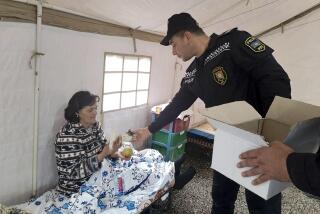Taliban Forces Retreat After Rebel Assaults
- Share via
DALLAN SANG, Afghanistan — Taliban forces were collapsing and in retreat across a large swath of northern Afghanistan on Saturday, opposition forces claimed a day after seizing the strategic city of Mazar-i-Sharif.
U.S. warplanes continued to bomb several thousand Taliban troops as they fled west and south from Mazar-i-Sharif in cars, trucks and on foot, according to Younis Qanooni, interior minister of the opposition Northern Alliance.
Alliance officials said they had taken control of five provinces in the northeastern part of the country--Balkh, Jowzjan, Faryab, Sar-i-Pol and Samangan--bringing their two fronts within 50 miles of each other.
Although none of these reports could be independently verified, the Northern Alliance would control about one-third of Afghanistan should the fronts merge. When U.S. airstrikes began Oct. 7, the alliance controlled no more than 10% of the country.
“We have completely liberated this territory from the hands of the Taliban,” Mukhamat Sardor Saidi, political officer to Northern Alliance commander Haji Mohammed Mukhaqiq, said by satellite telephone from Mazar-i-Sharif. “I can promise you that soon, all of Afghanistan will be liberated from the Taliban.”
In New York, however, President Bush said at a news conference with Pakistani President Pervez Musharraf that the alliance should not move into the capital, Kabul. Bush’s remarks seemed aimed at ensuring that any new government would include representatives from all of Afghanistan’s main ethnic groups. The Northern Alliance is mostly ethnic Uzbeks and Tajiks, while ethnic Pushtuns dominate the Taliban, as they do much of the country.
Qanooni, the Northern Alliance interior minister, said in an interview that the fall of Mazar-i-Sharif and the Taliban’s hasty retreat across the north proved what he has been saying for weeks: Washington doesn’t need to send large numbers of ground troops to Afghanistan to get rid of the Taliban.
“I have always had one conclusion about the Taliban: They are similar to an ‘unbreakable’ glass pot,” he said. “Whenever one part of it does break, the whole pot will shatter.”
As alliance commanders claimed to have Mazar-i-Sharif under control, however, a fierce battle with more than 1,000 Taliban holdouts was reportedly raging in the city center, Mukhaqiq said.
“We have pleaded and are pleading with them to surrender,” he said, “but they would prefer to die. They say, ‘We are moujahedeen. We are here to make jihad, and we will not surrender. We will fight to the death.’ ”
Saidi and other sources said that the Taliban fighters--largely Arabs, Pakistanis and other non-Afghans--were holed up in a former women’s school. The holdouts were believed to be reinforcements moved into the city in recent days. It was not clear why they did not retreat along with the rest of the Taliban forces, who abandoned their positions Friday night.
Saidi said that Northern Alliance leaders had sent in a copy of the Koran as a sign of goodwill and were trying to persuade the fighters to surrender.
“We’re saying: ‘You’re Muslims. We’re Muslims. Let’s join together, fight on the same side,’ ” he said.
Mukhaqiq said that some of those barricaded inside the school had escaped and holed up inside nearby apartments, where they were using the residents as hostages.
Meanwhile, two ethnic Pushtun-dominated provinces in northern Afghanistan--Kunduz and Takhar--remained in Taliban hands Saturday, and battles continued for control of a third, Baghlan. If the Northern Alliance gained control of Baghlan, its forces would connect with those besieging Kabul, to the south, and cut off the two Taliban-controlled northern provinces from the capital.
Saidi said jubilant local Afghans had come out to greet Northern Alliance forces as they advanced.
“All the people of northern Afghanistan are very tired of the Taliban,” he said. “All the people came out from their places of work and their homes and came up to us in the street. . . . That is why we were able to capture all this territory so quickly.”
Indeed, Northern Alliance officials described the capture of Mazar-i-Sharif as a turning point in the war. They said that in coming weeks, they plan to restore the city’s infrastructure and establish a civilian administration.
But Qanooni’s description of the alliance’s battle plans suggested that Afghanistan could end up divided between the Taliban and opposition forces for months to come.
The Taliban’s main escape routes west and south indicated that they would form a new front line in either Badghis or Herat provinces, in the far west of the country on the Turkmen and Iranian borders, Qanooni said.
If the Northern Alliance managed to drive the Taliban south “to the gateway of Kabul” and then surround the capital in the coming weeks, the opposition would not pursue the Taliban into its Pushtun strongholds around Kandahar and Jalalabad, he added.
“We are not interested in deploying our forces in Kandahar because that will create tribal reactions,” Qanooni said.
Instead, the alliance would leave the Taliban heartland to Pushtun opposition leaders.
Hamid Karzai, an exiled Pushtun leader, is working in Afghanistan to rally opposition to the Taliban. And Haji Abdul Qadir, former governor of eastern Nangarhar province and now a central figure in the Northern Alliance, is working to overthrow the Taliban from his former stronghold in Jalalabad, where he once ruled a fiefdom.
Qadir’s brother, Abdul Haq, was executed by the Taliban last month after he was captured while trying to rally Pushtun opposition against the Taliban.
Qanooni said the alliance has been in contact in recent days with Taliban commanders northeast of Kabul who are interested in defecting. Any such moves would follow a well-established pattern in Afghan conflicts, in which regional and local commanders defect once they sense which way the momentum of a battle is heading.
“The developments in the north of the country have been very effective” in persuading some Taliban commanders to consider switching sides before it is too late, according to Qanooni.
The opposition alliance continued to build up its forces north of Kabul ahead of a long-awaited ground offensive against the Taliban’s front lines. Four tanks were seen heading south toward the front line through the city of Charikar about 4 p.m., and soldiers normally based in the Panjshir Valley were ordered to muster in the town of Jabal os Saraj.
A heavy day of U.S. bombing allowed the Northern Alliance forces to break through the Taliban’s lines south of Mazar-i-Sharif and enter the city at 8:30 p.m. Friday, Qanooni said, asserting that the Taliban “put up only light resistance.”
“They were surprised and frantic. This has been a heartbreaking scene for the Taliban,” he said.
Taliban forces were in such disarray as they fled that they left behind 95 of their fallen soldiers’ bodies and took none of their tanks or other heavy weapons with them, he said.
By Saturday morning, the Taliban forces had abandoned their positions as far south as Pul-i-Khumri, about 110 miles southeast of Mazar-i-Sharif on the main highway to Kabul, according to Qanooni.
They were also heading east from Mazar-i-Sharif toward Kunduz, where Qanooni said they risked being trapped. The Taliban surrendered the province of Jowzjan, west of Mazar-i-Sharif, on Saturday morning, Qanooni said, and were retreating across neighboring Faryab province.
If the opposition forces take the crossroads town of Dowshi, about 20 miles south of Pul-i-Khumri, the alliance would be able to regain control of the highway linking northern Afghanistan with Kabul.
The final step would be clearing the Salang Tunnel, the highest in the world at 11,034 feet, Qanooni said. The opposition forces blew up both ends of the 1.6-mile tunnel in 1997 to block a Taliban offensive.
“Opening the Salang is critical to us, but it will take time,” he said. “But we will not postpone our offensive to the north of Kabul in order to wait for the Salang to be opened.
“It is difficult to fix a time for surrounding Kabul,” he added. “But we hope to carry out this plan in one or two weeks’ time.”
U.S. airstrikes and airdrops of ammunition and food for horses used in cavalry charges certainly helped in the attack on Mazar-i-Sharif, but solving “coordination problems” among rival Afghan commanders was the key, Qanooni insisted.
The alliance’s military commander, Gen. Mohammed Qassim Fahim, and Qanooni talked separately to the commanders to stress the need to work together, the interior minister said.
“We told them, ‘Your coordination is the first condition of your success,’ ” Qanooni said. “Then they sat with one another and arranged their plans.”
Saturday night, the three main commanders--Abdul Rashid Dostum, Ata Mohammed and Mukhaqiq--held a strategy meeting to plan their next moves. All are under the command of Fahim.
Mohammed Hasham Saad, the Northern Alliance ambassador in neighboring Uzbekistan, said he was already lobbying the Uzbek government to open a bridge connecting Afghanistan to Uzbekistan. International aid groups are eager to move food and other humanitarian aid into the Afghan interior. He said the bridge could open within days.
“We are trying to talk to our Uzbek friends and some other friends in the United Nations,” Saad said. “I think they will need a little time.”
The commanders are already using their victory to press the Pentagon for closer coordination and more and heavier arms. Dostum is asking the United States to give him helicopter gunships, armored personnel carriers and other weapons, said Philip S. Smith, his liaison in Washington. Dostum, who Smith said marched into Mazar-i-Sharif with 8,000 men on foot and 1,000 on horseback, used Soviet helicopter gunships, tanks and MIG fighter jets to capture and control the city in the 1990s.
Smith said Dostum now wants to make a “quantum leap” in arms, from horses to armored tanks and Apache helicopters, which Smith said the commander has the pilots to fly.
“Now that the land routes are about to open up, as the government of Uzbekistan has indicated, it would seem feasible for these sorts of weapons to be delivered, and they ought to be delivered,” Smith said. “Before the liberation of Mazar-i-Sharif, these sorts of requests may have seemed a little bit overly ambitious, but I think now it’s within the realm of reason--not only reasonable but, I think, necessary to conduct an effective campaign against the Taliban.”
*
Watson reported from Dallan Sang and Reynolds from Tashkent, Uzbekistan. Times staff writer John Hendren in Washington contributed to this report.
More to Read
Sign up for Essential California
The most important California stories and recommendations in your inbox every morning.
You may occasionally receive promotional content from the Los Angeles Times.













